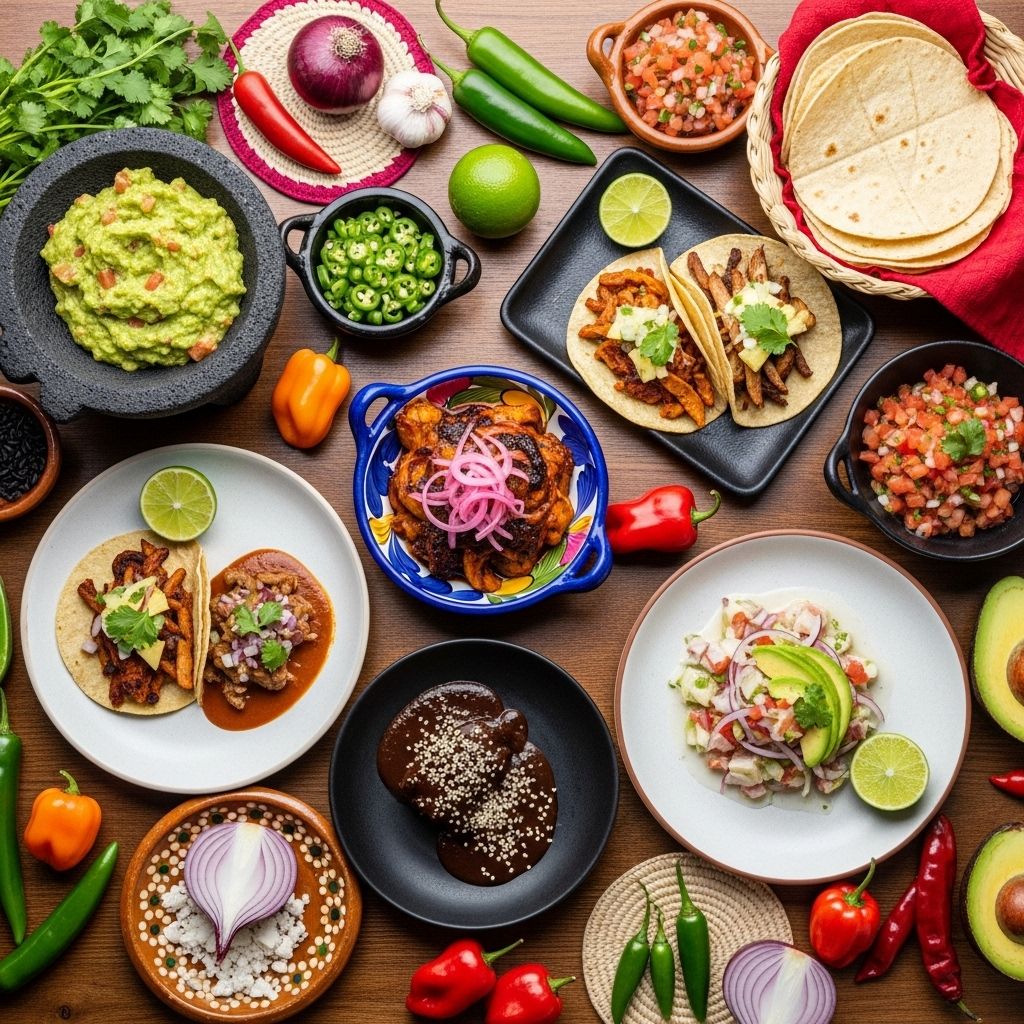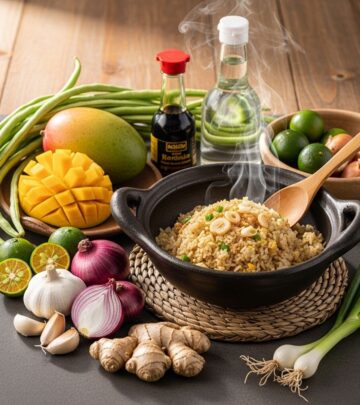Mexican Recipes: Ultimate Guide To Classic & Regional Dishes
Discover the vibrant flavors, recipes, and culinary traditions of Mexico, from street food staples to authentic home-cooked classics.

Image: HearthJunction Design Team
Mexican Recipes: Exploring Classic & Regional Mexican Cuisine
Mexican cuisine is celebrated worldwide for its bold flavors, vibrant colors, and rich cultural heritage. From street food staples like tacos and quesadillas to complex, traditional dishes like mole and cochinita pibil, the culinary landscape of Mexico is as diverse as its people. This comprehensive guide delves into the heart of Mexican cooking, offering a curated collection of beloved recipes, regional specialties, and handy tips to help you recreate the magic of Mexico in your own kitchen.
Table of Contents
- Introduction to Mexican Cuisine
- Mexican Appetizers
- Mexican Soups and Stews
- Mexican Main Dishes
- Mexican Sides
- Mexican Desserts
- Regional Mexican Specialties
- Essential Ingredients in Mexican Cooking
- Frequently Asked Questions (FAQs)
Introduction to Mexican Cuisine
Mexican cuisine reflects centuries of blending indigenous ingredients and European influences, resulting in a dynamic food culture that’s beloved for its hearty, comforting, and festive flavors. The country’s culinary traditions vary greatly from one region to another, featuring ingredients like corn, beans, avocados, tomatoes, peppers, and a variety of spices. Whether you’re craving a light street snack or a full festive meal, Mexican food offers something for every palate.
Mexican Appetizers
Kick off any meal with these classic Mexican starters—perfect for parties, gatherings, or anytime snacking.
- Guacamole: Creamy avocado mashed with lime, cilantro, tomato, onion, and jalapeño. Serve with tortilla chips for an instant hit.
- Pico de Gallo: A fresh salsa combining chopped tomatoes, onions, cilantro, lime juice, and peppers for a zesty dip.
- Mexican Street Corn (Elote): Grilled corn on the cob slathered in mayo, cotija cheese, chili powder, and lime. An iconic street food snack.
- Quesadillas: Tortillas filled with melted cheese (and sometimes other fillings like mushrooms or chorizo), folded and grilled until golden and gooey.
- Nachos: Corn chips topped with cheese, jalapeños, beans, and a variety of toppings, then baked until bubbly.
Mexican Soups and Stews
Hearty soups and rich stews are essential components of Mexican home cooking, providing comfort and robust flavor with every spoonful.
- Posole: A traditional soup made with hominy and pork (or sometimes chicken), richly flavored with red or green chile and garnished with cabbage, radishes, onions, and lime.
- Menudo: Slow-cooked tripe soup, renowned as a restorative dish and a celebratory staple at large gatherings.
- Chicken Tortilla Soup: A flavorful broth with shredded chicken, tomatoes, chiles, and crisp tortilla strips, topped with avocado and cheese.
- Sopa de Lima: A refreshing chicken and lime soup originating from the Yucatán, featuring aromatic herbs and crispy tortilla strips.
Mexican Main Dishes
The heart of any Mexican meal is its main course, featuring a range of celebrated dishes that showcase Mexico’s culinary legacy.
- Tacos: Perhaps Mexico’s most iconic dish. Soft or crispy tortillas filled with various meats (like carnitas, barbacoa, fish), vegetables, salsas, and fresh herbs.
- Burritos: Large flour tortillas wrapped around hearty fillings such as beans, rice, meat, cheese, and salsa. Burritos are especially popular in Northern Mexico and the United States.
- Enchiladas: Corn tortillas rolled around savory fillings (chicken, cheese, beans), topped with chile sauce and baked until bubbly.
- Fajitas: Sizzling grilled meats (traditionally steak or chicken) with sautéed onions and bell peppers, served with warm tortillas and assorted toppings.
- Quesadillas: A national favorite, as noted above, enjoyed as both appetizer and main course.
- Chiles Rellenos: Roasted poblano peppers stuffed with cheese, meat, or beans, battered, and fried, then topped with tomato sauce.
- Carnitas: Tender pork shoulder braised until crispy and shredded, perfect for tacos, burritos, or nachos.
- Mole Poblano: A complex sauce featuring chiles, chocolate, spices, and nuts, typically served over chicken or turkey.
Mexican Sides
Round out your meal with classic Mexican sides that bring balance and extra flavor to every plate.
- Mexican Rice (Arroz Rojo): Fluffy rice sautéed with tomatoes, garlic, onions, and sometimes peas or carrots.
- Refried Beans: Creamy mashed beans, usually pintos or black beans, cooked with lard or oil and seasoned with spices.
- Green Rice (Arroz Verde): Rice infused with green herbs and vegetables like cilantro, parsley, and poblano peppers, sometimes enriched with cheese and crema.
- Elote (Mexican Street Corn): Also featured as an appetizer or snack, elote can be served on the cob or off as “esquites.”
- Salsa and Chips: Crunchy tortilla chips paired with fresh or roasted salsas.
Mexican Desserts
Sweeten your meal with traditional Mexican desserts, many of which are enjoyed year-round and on special occasions.
- Flan: A silky caramel custard, beloved across Latin America and a staple of Mexican celebrations.
- Churros: Fried dough sticks dusted with cinnamon sugar, sometimes filled with chocolate or caramel and served with dipping sauces.
- Arroz con Leche: Creamy rice pudding flavored with cinnamon and vanilla.
- Mexican Hot Chocolate: A rich beverage made from Mexican chocolate tablets, spiced with cinnamon and sometimes a hint of chili pepper for warmth.
- Pastel de Tres Leches: A sponge cake soaked in three types of milk—evaporated, condensed, and whole—for a luscious, moist dessert.
Regional Mexican Specialties
Mexico’s broad geography and cultural diversity are reflected in its regional dishes—each one carrying the distinct flavors and techniques of its birthplace.
| Region | Signature Dishes |
|---|---|
| Yucatán Peninsula | Cochinita Pibil (slow-roasted pork in annatto sauce), Sopa de Lima |
| Puebla | Mole Poblano, Chiles en Nogada (stuffed poblano peppers in walnut sauce) |
| Oaxaca | Oaxacan mole, Tlayudas (large tortillas with beans, meat, and cheese) |
| Northern Mexico | Carne Asada, Flour tortillas, Burritos |
| Coastal Regions | Fish Tacos, Ceviche, Aguachile |
Spotlight on Classic Regional Dishes
- Cochinita Pibil: Slow-roasted pork shoulder marinated in annatto paste and citrus, then shredded and served with pickled onions and habanero sauce. A hallmark of Yucatán cuisine.
- Chiles en Nogada: Poblano peppers filled with spiced ground pork, covered in walnut sauce, and garnished with pomegranate seeds—originating from Puebla and symbolizing Mexican Independence.
- Authentic Mexican Hot Chocolate: Made with traditional chocolate tablets and a touch of chili, delivering a warming, mildly spiced drink.
- Green Rice with Cheese: A creamy and cheesy twist on arroz verde, rich with herbs, cheese, and Mexican crema.
Essential Ingredients in Mexican Cooking
No Mexican kitchen is complete without a handful of key ingredients that define the unique taste, aroma, and texture of its traditional dishes.
- Corn (Maize or Nixtamal): Used for tortillas, tamales, and many other staples.
- Rice (Arroz): Common side and base for many meals.
- Dried Beans: Pinto, black, and other varieties are foundational proteins.
- Tortillas: Both corn and flour varieties are central to Mexican cuisine.
- Chile Peppers: From mild to fiery, chiles add heat, complexity, and depth to countless recipes.
- Avocado: Essential for guacamole, salads, and fresh toppings.
- Cheese: Cotija, queso fresco, Oaxacan, and Chihuahua cheese feature in many dishes.
- Herbs and Spices: Cilantro, cumin, oregano, and epazote are frequently used to season food.
Frequently Asked Questions (FAQs)
What are the most popular Mexican recipes?
Tacos, enchiladas, burritos, quesadillas, and guacamole are enjoyed around the world and serve as introductory classics to Mexican cuisine.
What makes Mexican cuisine unique?
The use of regional ingredients, complex spices, and time-honored techniques—such as nixtamalization of corn and slow-cooking of meats—creates bold, layered flavors that set Mexican cuisine apart.
What is authentic Mexican food?
Authentic Mexican food emphasizes native ingredients like corn, beans, and chiles, often prepared using traditional methods and recipes passed down through generations. Many dishes are rooted in specific regions that reflect the country’s cultural diversity.
Are Mexican recipes spicy?
Many Mexican dishes feature chile peppers, but spice levels can be adjusted to taste. The cuisine often balances heat with bright, fresh flavors from herbs, citrus, and vegetables.
What are some must-try regional Mexican dishes?
Cochinita pibil (Yucatán), mole poblano (Puebla), tlayudas (Oaxaca), fish tacos (Baja California), and birria (Jalisco) are regional specialties worth seeking out.
Can I make Mexican food vegetarian?
Absolutely! Many Mexican staples are plant-based or can be easily adapted, such as bean tacos, cheese enchiladas, veggie fajitas, and salsas.
Conclusion
Mexican cuisine offers a world of flavors, history, and traditions to explore. Whether you’re making a quick guacamole for a weeknight dinner or tackling a regional specialty for a festive occasion, these recipes bring the vibrant taste of Mexico into your kitchen. Remember to experiment, share with friends and family, and celebrate the diversity that makes Mexican food so special.
References
- https://www.allrecipes.com/recipes/728/world-cuisine/latin-american/mexican/
- https://www.allrecipes.com/article/guide-to-regional-mexican-cuisine/
- https://www.allrecipes.com/article/regional-mexican-inspired-recipes-in-america/
- https://www.allrecipes.com/article/authentic-mexican-food/
- https://www.allrecipes.com/gallery/best-authentic-mexican-recipes/
Read full bio of medha deb












